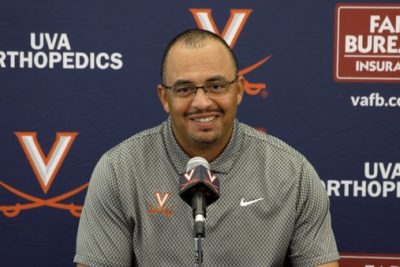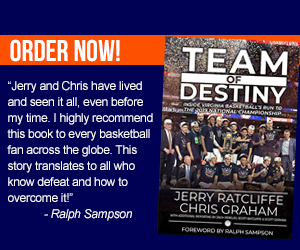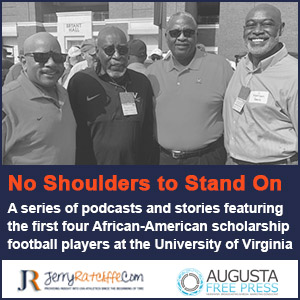Elliott: Defensive shortcomings not about ability, but communication, reps
By Jerry Ratcliffe
While Virginia is off to a fast start (3-1, could easily be 4-0), and with its offense putting up video game numbers ahead of its showdown with No. 8 Florida State, questions linger about the Cavaliers’ secondary.
In a 48-20 whomping of visiting Stanford, a team that relies heavily on its ground game, the Cardinal’s big plays came in the passing game. Stanford receivers got behind UVA defensive backs for a 68-yard touchdown, a 60-yard pass that set up a TD, and a pair of passes of 28 and 29 yards.
If Stanford could do that, then what might Florida State do? Armed with an offense that’s ranked No. 1 nationally in scoring (58 points per game) and total offense (629 yards per game), the Seminoles boast a fleet of receivers that are effective with everything from the screen game to jet sweeps to the deep ball.
We asked Tony Elliott about concerns in pass coverage, and knowing FSU offensive coordinator Gus Malzahn the way he does, what does the Virginia head coach expect come Friday night.
Elliott has a working knowledge of Malzahn, who has a strong history with Chad Morris, a former close colleague of Elliott on the Clemson staff, and father of UVA quarterback Chandler Morris. Malzahn and Chad Morris go all the way back to Morris’s high school coaching days in Texas.
Malzahn was a coaching role model for Morris, who was intrigued by Malzahn’s innovative offensive style.
“Yeah, I expect [Malzahn] to test us deep,” Elliott said at his game-week presser on Tuesday. “I mean, they tested Alabama over the top and everybody else that they played. That’s just a part of what the system is all about. They want to run it right at you between the tackles and then throw it over the top to test you.”
So, with Stanford, NC State and William & Mary enjoying success in explosive passing plays against Virginia, what’s going to happen when FSU throws it over the top?
Is Elliott concerned?
“I don’t have concerns from an ability standpoint,” Virginia’s coach said. “We’ve just got to be cleaner with our eyes and we’ve got to coach better to help these guys not see so much. That’s really the challenges that we have in learning the system. We’ve got to remind ourselves that all the guys that are playing in the secondary, with the exception of (Ethan) Minter and (Devin) Neal, weren’t here in the spring. So they’re all kind of growing up and learning on the fly with what we do.”
Virginia exited its spring drills still in need of experienced defensive backs. The Cavaliers went shopping in the transfer portal and brought in several new members to the secondary, players that had never practiced together until August training camp, and have now played together in only four games.
Elliott said that with Florida State having speed all over the field, his DBs can’t allow the Seminoles to get behind them like they did against Stanford.
“[The secondary] owned the couple of plays that we gave up last week, and we’re going back to work, and I’m excited to just see them go out and accept the challenge versus this bunch that’s coming here,” Elliott said.
Defensive coordinator John Rudzinski pointed out that making those corrections is usually pretty simple. Coach Rud said that fundamentally, the coaches need to put the secondary through more deep-ball scenarios in practice, “where the ball is 50 to 60 yards in the air” and continuing to give the players lots of reps.
Safety Antonio Clary, in his seventh and final year of college football, believes it’s a matter of the secondary gaining more playing time together. Clary returned to action against Stanford after suffering a knee injury last November, an injury that kept him out of action until last Saturday night.
“It’s just miscommunication,” Clary said of his defensive teammates. “It has nothing to do with ability at all. You can sit in our meetings … it’s just being able to communicate, being on the same page and that’s what it comes down to, especially on the defensive end and the back end.
“A lot of times, a lot of the exposure plays, it’s not because you just got flat out beat because of athleticism, really, it’s just because someone didn’t communicate, or collectively as a group, we didn’t communicate. That’s when breakdowns happen. You’re going to get beat here and there. That’s just the nature of football … you’re gonna get beat. But being able to limit those explosive plays by communicating, that’s the biggest thing.”
Clary said a big point of emphasis in this week’s practices has been making sure that everyone is on the same page, communicating at a high level, keeping receivers in front of them. The Cavaliers know that Malzahn is going to attack them, so there’s no more room for growing pains by the secondary.
In preparation for the Seminoles, the Virginia defensive backs are focusing on their scheme, adjusting to checks and being loud when communicating.
“Being in the heat of the moment of the game, sometimes you might say something, but not realize that the other person didn’t actually hear you,” Clary said. “So just being able to over-communicate, being loud and just understanding what the defense is asking us to do.”
Rudzinski said that Florida State’s passing game has been impressive, partly because of tons of depth and talent, partly because of versatile and mobile quarterback Thomas Castellano, formerly of Boston College. UVA beat BC last season and kept Castellano under wraps. This time around, he is surrounded by much more talent.
“[FSU] is fast,” Coach Rud said. “They can go. They’ve got some guys with some gear.”
Rud has been pushing his secondary in practice, preparing by attempting to simulate the Seminoles’ ability to push the ball downfield.
“At the same time, they do a nice job in their screen game and their three-step game and [receivers] creating extra yards after the catch,” Rudzinski said.
Malzahn makes teams choose their poison, either defending the deep ball and allowing shorter passes to skilled players who can turn those into big yardage, or cheating up to shut down the short game and screens, only to get burned deep.
“They’ve made a bunch of contested catches,” Rud said. “And we’ve seen guys cut people loose as well, and it literally was a wide-open receiver, so we’ve got to eliminate that. We’ve got to make sure we’re matched up right and force them to make contested catches, because when you allow an offense to throw into space to really good skilled [players], it can be a stressful night.”
One of FSU’s main targets is a big one in 6-foot-6, 223-pound Duce Robinson, a USC transfer, who had 173 receiving yards against East Texas A&M, including an 82-yarder.
As big as this game is, the last thing Elliott and Rudzinski need is a “stressful night,” as Rud pointed out. If it’s all about communication, then Virginia should be better.









